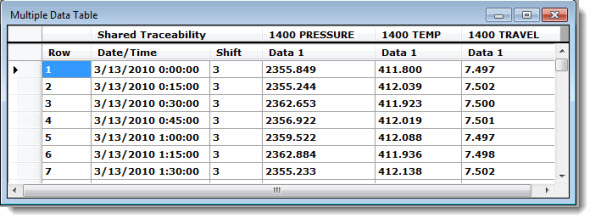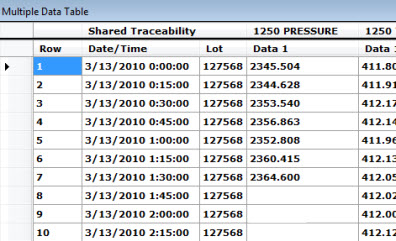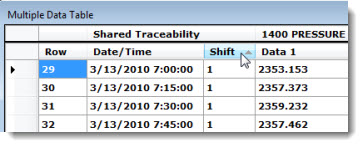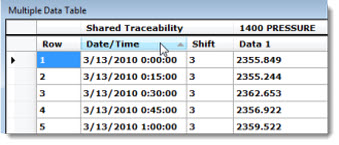
The Multiple Data Table allows comparison of the raw data from multiple retrievals that share a similar combination of date/time stamp and traceability values.
You can also configure GainSeeker to group similar date/time stamps (and define the maximum length of time for which to consider them "similar"), to compare specific traceability fields, or to sort data by traceability values instead of sorting by date/time stamps. This data format can easily be sent to MINITAB.

|
Contents [Hide] |
The Shared Traceability columns are used to match data records from different retrieval groups that share the traceability information displayed in the table. For example, in the table shown below, each retrieval group has a data record with the date/time stamp close to 3/13/2010 and the Lot number 127568.
However, a traceability label that is not selected as a Shared Traceability will not be used to match data records. For example, in the table shown below, each retrieval group in the first row may have different values for the traceability fields of shift, machine, cavity, department, and operator.

If a data record does not match the Shared Traceability values of a data record from a different retrieval group, it is still displayed on the Multiple Data Table, as in the following example for rows 8, 9, and 10. The cells will be empty in instances where there is no matching data.

Data records from different retrievals are ordered by how close the date/time stamps of each fall in relation to each other. By default, date/time stamps that fall within 10 seconds of each other are considered identical.
The date/time stamp displayed on each row of a Multiple Data Table is the actual date/time stamp of the first (left-most) data subgroup displayed on that row. The date/time stamps of the remaining subgroups displayed on that row may match exactly, or they may fall within the specified time period.
You can set the maximum time interval GainSeeker uses to match the data points of two or more standards on a table.
See Setting the allowable difference in seconds for information on changing this setting for a specific Data Table.
The default setting that GainSeeker uses to order retrievals can also be changed in the GainSeeker Administration module.
By default, a Multiple Data Table is sorted in ascending order by the first Shared Traceability column. Identical rows within that column are also sorted in ascending order by date/time stamp.
You can manually sort the data by any Shared Traceability column. Click the column header cell of which you want to sort the data in ascending order (Shift in Fig. 1). To resort the data by the first Shared Traceability column (Date/Time in Fig. 2), click the first Shared Traceability column header.
Fig. 1
Fig. 2